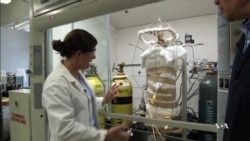For centuries, alchemists have tried to turn lead into gold. That transmutation has long been proven impossible, but another similar dream - turning water into fuel - seems to be achievable. Scientists at a U.S. Naval Laboratory proved it by flying a model airplane burning re-engineered seawater.
Natural gas and liquid fuels, burned in all kinds of internal combustion engines, are chemical compounds of hydrogen and carbon, coming mostly from underground reserves.
Oceans also are huge reservoirs of hydrogen, though, and - increasingly - carbon dioxide, or CO2. Dissolved in seawater from the air, it makes the water more acidic.
Extracting those chemicals from the ocean and converting them into a form of liquid fuel was made possible by some recent technological advances, according to U.S. Navy researcher, Dr. Heather Willauer.
“We've been actually able to show that we can recombine CO2 and hydrogen in the laboratory on a lab-scale, laboratory scale, into a liquid-type fuel,” she said.
The process requires a lot of electrical energy, which - to be economical - has to come from a cheap source, such as a nuclear power plant.
Economical electric energy
Obviously, the most efficient place to do it would be aboard a nuclear powered aircraft carrier. Willauer said these ships may someday manufacture their own jet fuel.
“Well, it is a game-changer potentially for the Navy or commercial entities because you can make fuel potentially where and when you need it,” she said.
The new fuel was tested successfully on a model airplane with a two-stroke engine. For now, making it requires twice as much power as the fuel can produce, but researchers hope to lower that ratio.
Willauer said the new process will not increase the amount of carbon dioxide in the atmosphere, which contributes to global warming.
“Once we've pulled it out of seawater, the ocean is ready to pull it back in from the atmosphere, 'cause it's in constant equilibrium. So what we hope is it's a carbon-neutral footprint,” she said.
Scientists hope a small scale industrial plant may start converting seawater into fuel within the next 15 years.
Natural gas and liquid fuels, burned in all kinds of internal combustion engines, are chemical compounds of hydrogen and carbon, coming mostly from underground reserves.
Oceans also are huge reservoirs of hydrogen, though, and - increasingly - carbon dioxide, or CO2. Dissolved in seawater from the air, it makes the water more acidic.
Extracting those chemicals from the ocean and converting them into a form of liquid fuel was made possible by some recent technological advances, according to U.S. Navy researcher, Dr. Heather Willauer.
“We've been actually able to show that we can recombine CO2 and hydrogen in the laboratory on a lab-scale, laboratory scale, into a liquid-type fuel,” she said.
The process requires a lot of electrical energy, which - to be economical - has to come from a cheap source, such as a nuclear power plant.
Economical electric energy
Obviously, the most efficient place to do it would be aboard a nuclear powered aircraft carrier. Willauer said these ships may someday manufacture their own jet fuel.
“Well, it is a game-changer potentially for the Navy or commercial entities because you can make fuel potentially where and when you need it,” she said.
The new fuel was tested successfully on a model airplane with a two-stroke engine. For now, making it requires twice as much power as the fuel can produce, but researchers hope to lower that ratio.
Willauer said the new process will not increase the amount of carbon dioxide in the atmosphere, which contributes to global warming.
“Once we've pulled it out of seawater, the ocean is ready to pull it back in from the atmosphere, 'cause it's in constant equilibrium. So what we hope is it's a carbon-neutral footprint,” she said.
Scientists hope a small scale industrial plant may start converting seawater into fuel within the next 15 years.












